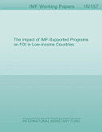Income Polarization in the United States
ივნ. 2016 · International Monetary Fund
ელწიგნი
36
გვერდი
reportრეიტინგები და მიმოხილვები დაუდასტურებელია შეიტყვეთ მეტი
ამ ელწიგნის შესახებ
The paper uses a combination of micro-level datasets to document the rise of income polarization—what some have referred to as the “hollowing out” of the income distribution—in the United States, since the 1970s. While in the initial decades more middle-income households moved up, rather than down, the income ladder, since the turn of the current century, most of polarization has been towards lower incomes. This result is striking and in contrast with findings of other recent contributions. In addition, the paper finds evidence that, after conditioning on income and household characteristics, the marginal propensity to consume from permanent changes in income has somewhat fallen in recent years. We assess the potential impacts of these trends on private consumption. During 1998-2013, the rise in income polarization and lower marginal propensity to consume have suppressed the level of real consumption at the aggregate level, by about 31⁄2 percent—equivalent to more than one year of consumption.
შეაფასეთ ეს ელწიგნი
გვითხარით თქვენი აზრი.
ინფორმაცია წაკითხვასთან დაკავშირებით
სმარტფონები და ტაბლეტები
დააინსტალირეთ Google Play Books აპი Android და iPad/iPhone მოწყობილობებისთვის. ის ავტომატურად განახორციელებს სინქრონიზაციას თქვენს ანგარიშთან და საშუალებას მოგცემთ, წაიკითხოთ სასურველი კონტენტი ნებისმიერ ადგილას, როგორც ონლაინ, ისე ხაზგარეშე რეჟიმში.
ლეპტოპები და კომპიუტერები
Google Play-ში შეძენილი აუდიოწიგნების მოსმენა თქვენი კომპიუტერის ვებ-ბრაუზერის გამოყენებით შეგიძლიათ.
ელწამკითხველები და სხვა მოწყობილობები
ელექტრონული მელნის მოწყობილობებზე წასაკითხად, როგორიცაა Kobo eReaders, თქვენ უნდა ჩამოტვირთოთ ფაილი და გადაიტანოთ იგი თქვენს მოწყობილობაში. დახმარების ცენტრის დეტალური ინსტრუქციების მიხედვით გადაიტანეთ ფაილები მხარდაჭერილ ელწამკითხველებზე.






